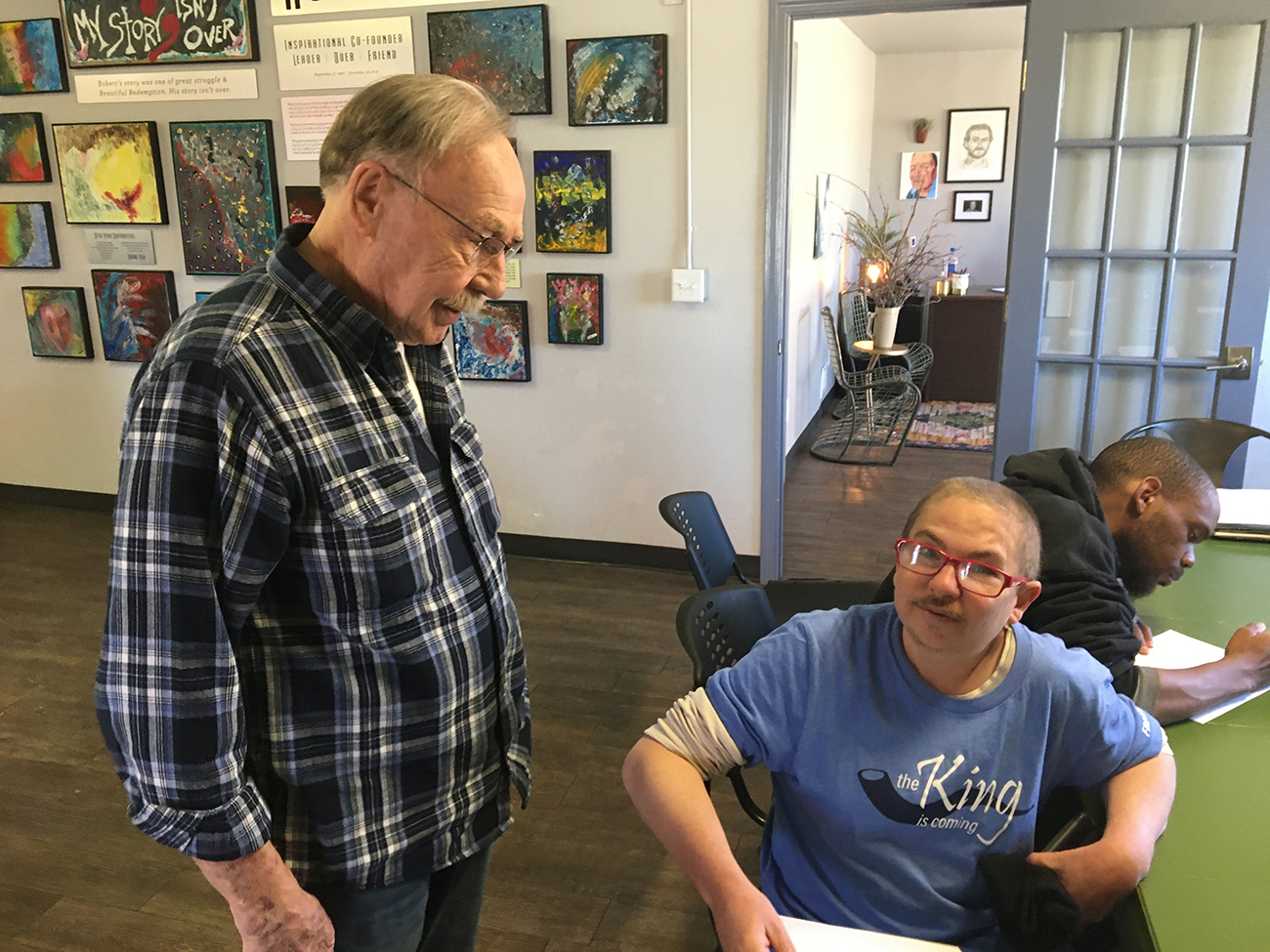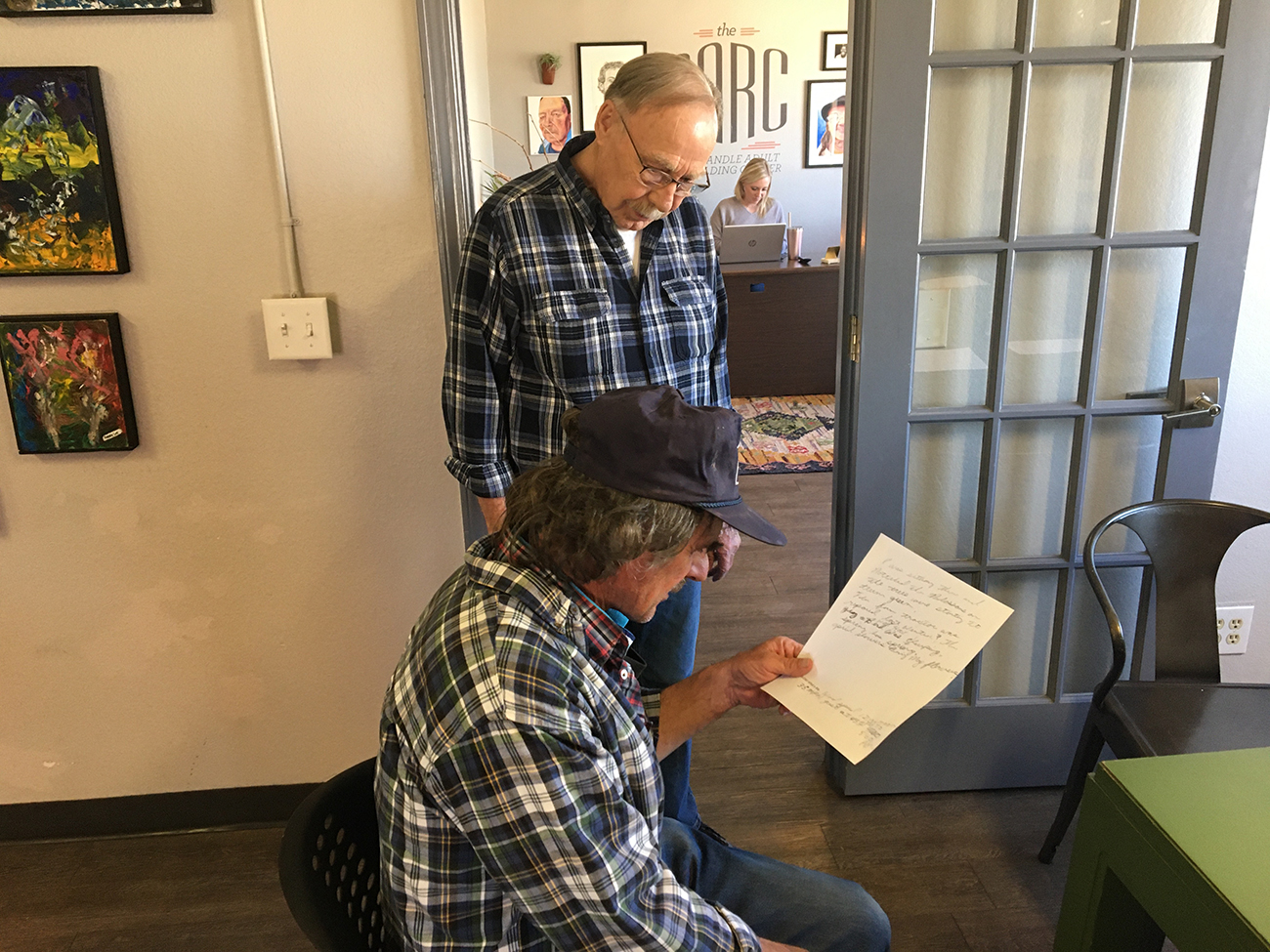- Jon Mark Beilue
- Featured
- Community
- Arts
Jon Mark Beilue: An unusual return to his roots
Russell Long, retired WT president, teaches writing to homeless
Russell Long was in his element.
The former president of West Texas A&M University has traded in the coat, tie, slacks and leather shoes that marked much of his career. On this Thursday morning, he wore a flannel shirt over a T-shirt, jeans and Nike shoes. He blended in seamlessly with his 14 students.
“I swear,” he said, “I’m learning more from them than they are from me. I absolutely love it.”
Long teaches a creative writing class, a return to his roots as an English literature professor. But he’s not a visiting professor in a college class. This is not a continuing education course, not a seminar, not a high school.
It’s the Panhandle Adult Rebuilding Center on Sixth Avenue in downtown Amarillo, and his 14 students are homeless men and women. The number of retired college presidents with a street named after them who are teaching a writing class to people without homes probably ends at one.
“I’d love to know why he’s doing it,” said Paul Colby, one of his students. “That’s one of the conversations we haven’t had yet. He’s one of the most patient people I know. He’s quiet and reserved, but at the same time he can be witty and allows us to be expressive.”
So why has Long taught a weekly creative writing class to the impoverished for nearly four years? It’s a matter of connecting the dots.
He’s always loved the written word, going back to when he was a boy in Van Horn, about 120 miles southeast of El Paso. At one time, he wanted to be an engineer but didn’t enjoy putting things together and much as he did words. Since he retired, he’s had one novel published, “An Unexamined Life,” and written three more as part of series.
He’s still the second-most prolific writer under his roof. Natrelle, his wife, has published four novels and is working on another.
Despite moving into the highest level of university administration, Long has always been a teacher at heart. In the 11 years he served as the ninth president of WT, ending in 2005, enrollment increased 10 percent, $92 million in campus improvements were undertaken, and 18 academic programs were added. But being the head of the English department at Tarleton State University gave him as much fulfillment.
The final dot reaches the homeless population. Juliana Kitten, director of community development for the City of Amarillo, is a friend of Natrelle’s. As such, she is director for the city’s homelessness programs. Several years ago, the Longs attended some of Kitten’s events.
“I got real interested in this,” Russell Long said. “There are so many misconceptions about homeless people, but I find them just fascinating to be around. I think so often that I have a wonderful wife, a comfortable home and adequate income, but one or two mistakes, or if I didn’t have this go right for me, none of this would exist.”
With his interest in the homeless population piqued, he was at a fundraising event for the PARC, co-founded 7 ½ years ago by Valarie Gooch. In short, the PARC is a place where homeless people can come during the day to feel valued and productive.
It’s not a day room to watch TV. It’s a place for classes, for developing intellectual skills, for gaining confidence that leads to employment, housing and growth.
“I asked Valarie if there were anything I could do here, that I’d like to be involved,” Long said.
She asked if he’d be willing to teach a class.
“I certainly would be willing to try,” Long said.
Improving the creative process

Photo: Dr. Russell Long has taught creative writing classes at Panhandle Adult Rebuilding Center for nearly four years.
Some weeks there are more than 20 in attendance for Long’s class, and some weeks as little as five. All have scar tissues from life, and no scars are the same.
There’s a man who graduated from college, a woman with both a bachelor’s and master’s degree. One man can barely read or write, but badly wants to learn.
One woman’s father was a country musician who after every performance would come home drunk and beat her mother. She ran away from home at age 13 and has been on the street ever since. One younger man, who recently found employment, was orphaned at age 3, graduated from the foster system at age 18 with no job skills or family and drifted.
On this first Thursday in April, there are 14 – 11 men, three women — gathered at three tables at the PARC. They have blank white sheets of paper and pencils.
“One of the things I want you to think about when writing a story is time,” Long tells them. “Are you writing your story from the past, or the present, or the future?”
He gave them their assignment. He gave them a one-line ending to their story – “Wow, what a day!” They were to fill in the rest and eventually read it to the class.
One woman read about moving into a new home during threatening storms. Another read of a spontaneous day that began in Amarillo and ended in Santa Fe. A younger man read of a hot streak at the craps and blackjack tables in Las Vegas.
Another talked of the blessings in her life, while another story was a darker one, a hungry wolf looking for food, preying on the homeless.
“Some treat this like a traditional class, and for some, it’s a new experience,” Long said. “Like I say, I’ve learned more from them than they have from me.”
Written on the walls on the east side of the PARC: “Be Productive. Be Encouraged. Be Yourself.” There are several artistic classes inside the building. Creative writing for the homeless may seen frivolous on the surface, but Gooch said there is value in the exercise.

Photo: Joseph Kerekes takes a creative writing class at the PARC taught by Dr. Russell Long, former WT president. "I'm honored honestly," Kerekes said. "I think that's pretty cool."
“Studies show improving the creative process opens the mind and starts to get them to think,” she said. “They have no opportunity to do this anywhere else. When they finish a story, or if they finish a drawing, I can say, ‘Hey, that looks good,’ and I can watch them change. They have more confidence. They see themselves differently. It’s so simple, but it’s so powerful.
“When Russell came here, I think he thought it might be a curriculum like college, and so I’ve watched him adapt to the people who come to the PARC. It is one of the most unique classes we have. I love watching him be himself in this environment.”
Long’s objective is to get his unique students to examine their own life experiences, see how mistakes or lapses in judgment changed their life’s course, and think how that can be fixed through a real or fictional character. It’s the way he’s always seen teaching.
“When you spend your life like I have as an educator,” Long said, “basically what I’m trying to do is get people to work to make their lives better. After I retired, I missed the sense of doing that. I didn’t want to sit and look out at the window. I find it very rewarding because I really do feel like I’m doing something to help them.”
Top photo: Dr. Russell Long, right, goes over an assignment with Doug, one of Long's students in a creative writing class for homeless men and women at Panhandle Adult Rebuilding Center.
Do you know of a student, faculty member, project, an alumnus or any other story idea for “WT: The Heart and Soul of the Texas Panhandle?” If so, email Jon Mark Beilue at jbeilue@wtamu.edu .

